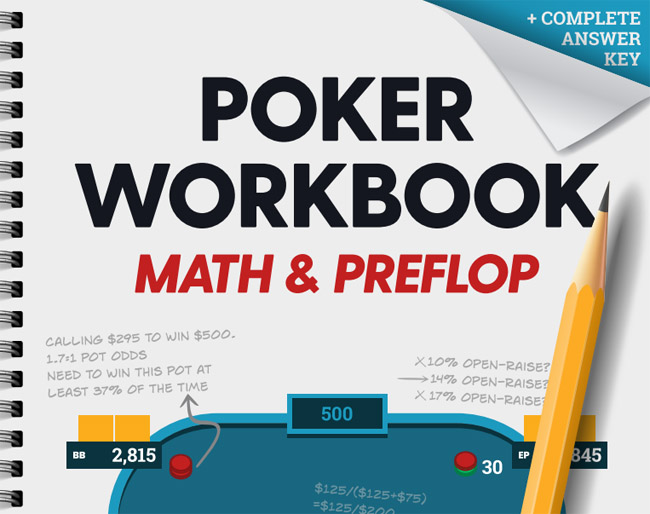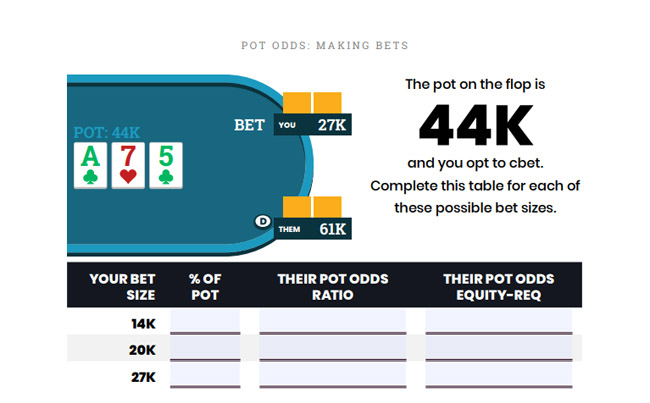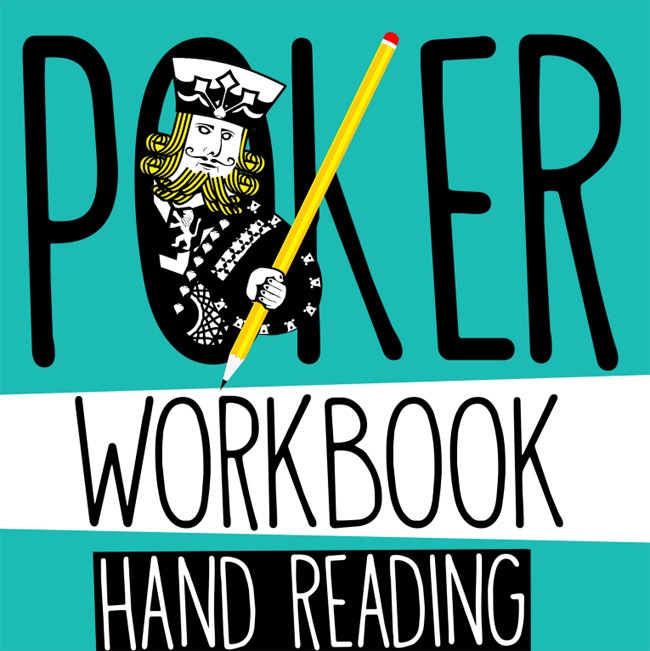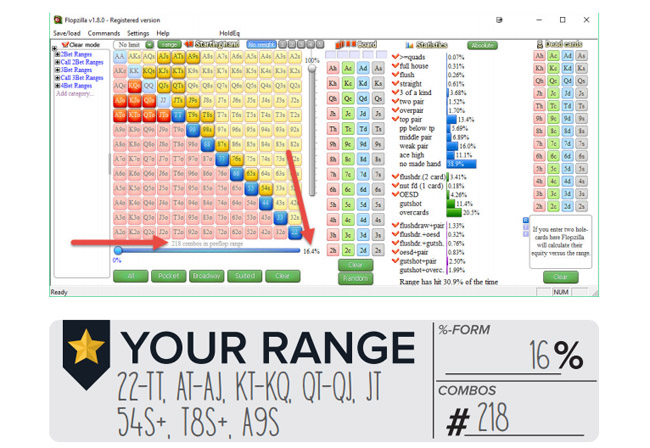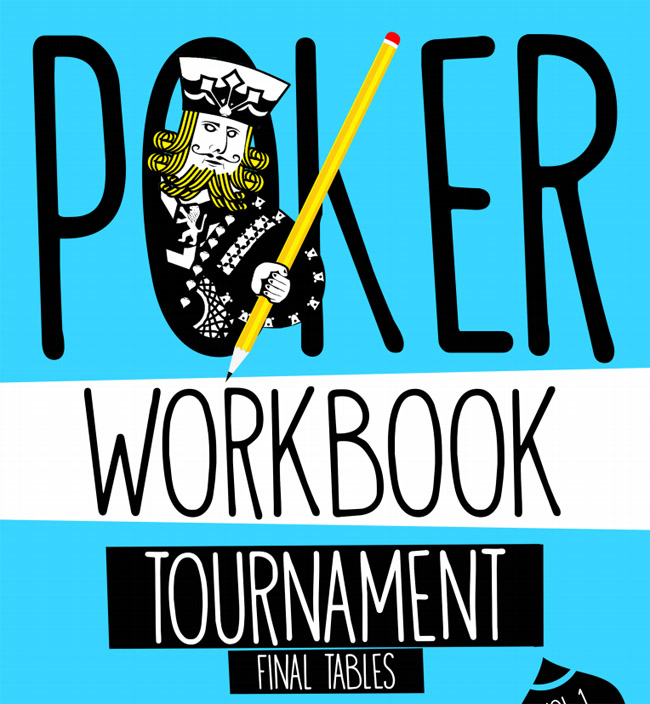These days, if you heard the mention of poker coaching, you automatically think of training videos or perhaps one-on-one sessions with a poker coach. The power of new technology and fast internet speeds have created many great opportunities and the way people learn to play poker has changed a lot as well.
Back in the day, if you wanted to learn something new about the game, you had to do a lot of reading as poker books and articles were the main source of knowledge. Videos were initially non-existent, then they were a rare commodity, and it took a while for them to become a standard feature.
But even in today’s modern era with many online poker training options, there is something to be said about learning from the books, especially if you ask James ‘SplitSuit’ Sweeney. The man who’s been an avid poker player himself and a successful poker coach for years believes that learning via workbooks still has its advantages and can be helpful in mastering certain aspects of the game.
For that reason, he’s published four different poker workbooks, each one targeting and explaining a particular area of the game. In this article, you’ll find out what these four books are all about, how you can benefit from them, and if they’re something you need.
Learning the Numbers
For those new to the game or people looking to get their basics improved upon, Sweeney’s Math & Preflop represents an excellent resource. This is an aspect of the game that you can’t simply learn by hearing about it and watching the game. You need to do some actual work to understand why things are the way they are and memorize the most important facts and figures.
So, presenting this type of knowledge in a form of a workbook works very well.
In the foreword to his Math & Preflop poker book, SplitSuit himself admits that math isn’t the most exciting thing in poker, which is why so many players try to hide from it. There is nothing unnatural about this tendency. But, at the same time, there is no good poker player who doesn’t have a deep understanding of these mathematical concepts – it’s simply not possible.
To start, the book introduces several software solutions you’ll need to have to make most out of it. These are Equilab, Flopzila, and Flop Cruncher. You’ll need to download at least one of these programs and have it handy. Equilab is completely free and if you’re serious about getting better at poker, you should have this piece of software installed anyway.
Once you have the tools, you can proceed to the actual contents of the workbook. It is divided into a number of chapters, each covering a specific area of the game, like:
- Equity setups
- Building ranges
- Pot and implied odds
- EV
- Open-raising
- 3-betting and squeezing, etc.
There isn’t a single area of poker math that isn’t covered in Sweeney’s textbook so if you’re willing to learn, the knowledge is there for the taking.
You won’t get overwhelmed by heaps of text, either. For each chapter, there is an explanation of the concept that is being discussed, taking up a few pages. This is followed by a series of questions about the topic that you need to try and give an answer to.
There is an answer key provided at the end of the book that you can download as a separate file. Thanks to this, you don’t have to waste time going back and forth every time you need to check answers. It’s quite handy and saves time.
I’m not going to go into a detailed analysis of each chapter here. It suffices to say that the Math & Preflop workbook by James Sweeney covers everything you need to know, especially with regards to preflop situations where it’s much easier to work out the important math.
However, you need to be prepared to put in the work.
The book contains 250 pages and the bulk of the content is made up of quizzes. SplitSuit does a good job of explaining concepts but he leaves a lot to the reader as well. If you can’t get the answers right on your first try, you should go back to the explanation and try to figure out what it was that you had missed or failed to understand.
Some things in poker are maybe better explained through videos but when it comes to math and numbers, I actually like Sweeney’s approach. It’s not entertaining (nor he makes such promises) but it does force you to really learn the stuff. If you don’t, you’ll know right away because you won’t be able to pass the quizzes, so it’s much harder to trick yourself into thinking “you got this”.
Hand Reading Books: Full Ring & 6-max
Figuring out your opponent’s likely holdings in a given situation is one of the most essential poker skills. However, only the best players know how to do it properly and think in terms of ranges instead of specific hands. This is a skill takes time and quite a bit of hard work to develop.
Sweeney has devoted two of his workbooks to essential hand reading skills and both have almost identical structures. These workbooks can be paired very well with the hand reading lab course, also by Sweeney. One of the hand reading workbooks is devoted to full ring live games, while the other workbook focuses on 6-max online tables. So, examples and questions you’ll find inside are relevant to the specific game type.
Both Hand Reading workbooks are divided into three main sections:
- Section 1: Understanding and structuring your own ranges
- Section 2: Exploring your opponent’s range
- Section 3: Range vs. Range
Each of these sections is followed by a few dozen assignments you’ll need to complete to check how well you understand the basic idea that’s being presented. Sweeney provides you with all the relevant information you need to get the right answers such as action up to the certain point and opponent’s HUD stats like VPIP, PFR, 3-bet percentage, etc.
Structuring Your Range
The first section of Hand Reading workbooks talks about the importance of understanding your own ranges and frequencies. Figuring out what your range is in a particular spot is the starting point for any further hand reading. Then, you need to start thinking in terms of what other players’ ranges might be and how this should influence your range: i.e. should you maybe scale back against someone or you can open up a bit.
SplitSuit goes into detail to explain how you can use Flopzilla to do this type of work and create ranges across various flop textures. The focus is on figuring out ranges and not exact hands, though, so many hands from the examples later on don’t even go to a showdown. It may bother you at first but it is actually a good way to force you to focus on what’s actually important.
Exercises that follow after the introductory part are geared at helping you figure out if there are certain leaks in your ranges or frequencies. Using Flopzilla, you can create ranges that you believe would be fitting for a particular situation and choose what the best option is for the certain part of your range (bet, check, call).
When you’re done, you can compare your answers to the answer sheet and see how you did. Maybe you won’t always agree with the solution offered by the workbook but that’s not that big of a deal. The main goal of these workbooks is to make you a more technical player and deepen your understanding of ranges and their significance in poker.
Exploring Opponents’ Ranges
The next section in both workbooks moves away from your hands and focuses on the opponents. After going through Section 1 and doing exercises, you should have a pretty good idea of how to build a solid, reasonable range for a particular situation.
You can now apply that knowledge to your opponents.
Examples and exercises in this section are aimed at providing you with the means to become better at making “educated guesses” about your opponent’s likely holdings and how to best proceed against these perceived ranges.
By the time you’re done with exercises, you’ll have a much better understanding of betting frequencies and combos, both of which will help you make better decisions, especially when facing a bet or deciding whether to fire the final bet yourself.
Once again, before you start, you’ll get all the information and advice you need on how to work with Flopzilla to get the best results. As Sweeney explains himself, this can be a bit frustrating and boring if you aren’t used to doing this kind of work but you’ll just have to get through it. No pain, no gain – as they say.
Hand examples you’ll need to go through will set different kinds of scenarios. Based on the information you are given and the information you get from Flopzilla, you’ll then need to figure out what is the best option to go with.
Range on Range Battles
The final section of both 6-max Cash Games and Hand Reading workbooks represents the culmination of everything that’s been discussed up to this point. In this section, you’ll learn how to effectively apply this knowledge and combine what you know about your own ranges and frequencies and what you know about your opponents to make the best possible decisions.
The Section 3 introduces concepts such as perceived range and range advantage, both of which you’ll find very useful in your poker career. Understanding why some board textures favor a certain player, be it the original raiser, 3-bettor, or the defending player, will make a huge difference for your bottom line in the long run.
Like the previous two sections, this one contains a bunch of exercises for you to work through. By this point, you should have a good idea on how to do things correctly, so it’s about putting your head down and doing the work.
Summary
The final section of both Hand reading and 6-max Cash Games workbooks contains glossaries and explanations of terms and abreviations used, which can be very useful if you’re somewhat new to online poker. SplitSuit also explains various HUD stats that have been used throughout workbooks, giving you a better understanding of what they are and how they can be of use to you.
I’m not going to lie – this isn’t the funniest or the most exciting way to learn poker. It feels a lot like going back to school. All the exercises, calculations, and assignments might make your head spin and even make you doubt your willingness to go through with it.
But, the bottom line is, this approach works if you are willing to stick with it.
Every assignment makes you really think about the situation at hand and the fact you need to manually input cards and ranges gets you even more involved. While there are definitely more entertaining ways to learn about poker, ranges, and hand reading, the knowledge you get from doing it this way will stick with you – guaranteed!
The Final Table Workbook
Everyone who plays poker tournament knows that it’s making final table that counts and, moreover, it’s how you perform at those final tables that will a huge impact on your bankroll. The fourth poker workbook by James ‘SplitSuit’ Sweeney is designed specifically to improve this segment of your play.
The book is similar in structure to the previous two as it is divided into three main sections discussing your own ranges, opponents’ ranges and frequencies, and, finally, how ranges stack against each other.
However, being the book on tournaments and the final table play in particular, it also talks about concepts such as ICM and player types. This is the additional information you’ll need to consider when doing exercises and trying to come up with correct decisions.
Although payouts are always given as a relevant piece of information to help you arrive to the right decision, some players may feel not enough emphasis is put on ICM. It’s true that Sweeney doesn’t force you to download another program just do to ICM calculations but focuses more on a common sense approach.
With dozens of examples to go through, putting you in all sorts of spots and tasking you with various tricky final table decisions, this poker workbook will definitely help you develop a much deeper understanding of the FT play.
Conclusion: Can You Learn Poker from Workbooks?
So, after going through all four books, it’s time to pass the final judgment. Is this really the best or the optimal way to learn poker or at least improve on the concepts discussed in the books? There is only one honest answer to that question.
It depends.
I don’t think that Sweeney’s books are something casual players would get overly excited about. Using this material correctly involves a lot of work and taking time to really understand concepts presented inside and, let’s be honest, most casual players don’t have enough patience to fold more than five hands in a row.
But, for someone who’s really keen on learning and who wants to get to that next level, these workbooks are an excellent resource. It takes things from casually watching videos to actually grinding the numbers yourself and figuring out what the answers are and why they are the way they are.
You’ll need to love the game and the technical aspect of it for these workbooks to really appeal to you. But if you do, going through these various assignments won’t feel like a chore at all. In fact, it’ll be a fun challenge and something like a daily puzzle you can spend a couple of hours on every day, improving your game and enjoying every moment of it.

